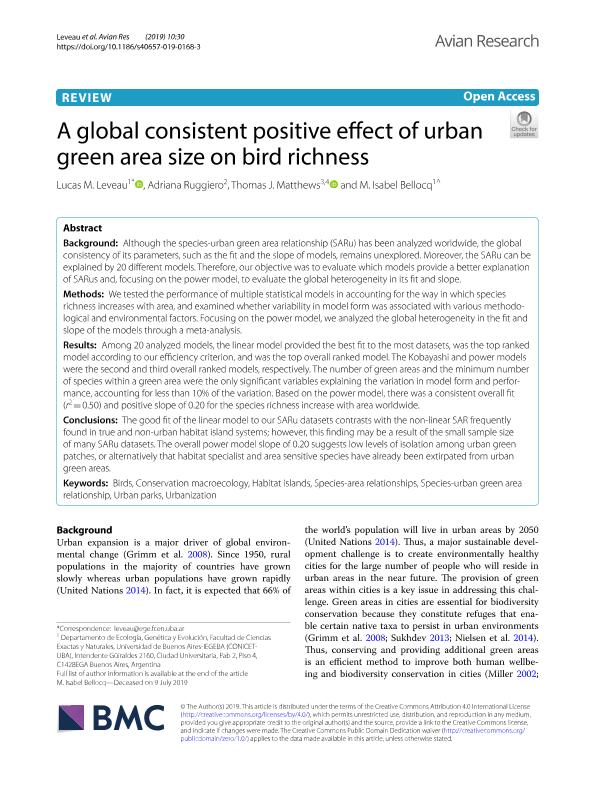Mostrar el registro sencillo del ítem
dc.contributor.author
Levau, Lucas M.
dc.contributor.author
Ruggiero, Adriana

dc.contributor.author
Matthews, Thomas J.

dc.contributor.author
Bellocq, Maria Isabel

dc.date.available
2021-01-08T18:18:00Z
dc.date.issued
2019-08-21
dc.identifier.citation
Levau, Lucas M.; Ruggiero, Adriana; Matthews, Thomas J.; Bellocq, Maria Isabel; A global consistent positive effect of urban green area size on bird richness; BioMed Central; Avian Research; 10; 1; 21-8-2019; 1-14; 30
dc.identifier.issn
2053-7166
dc.identifier.uri
http://hdl.handle.net/11336/122010
dc.description.abstract
Background: Although the species-urban green area relationship (SARu) has been analyzed worldwide, the global consistency of its parameters, such as the fit and the slope of models, remains unexplored. Moreover, the SARu can be explained by 20 different models. Therefore, our objective was to evaluate which models provide a better explanation of SARus and, focusing on the power model, to evaluate the global heterogeneity in its fit and slope. Methods: We tested the performance of multiple statistical models in accounting for the way in which species richness increases with area, and examined whether variability in model form was associated with various methodological and environmental factors. Focusing on the power model, we analyzed the global heterogeneity in the fit and slope of the models through a meta-analysis. Results: Among 20 analyzed models, the linear model provided the best fit to the most datasets, was the top ranked model according to our efficiency criterion, and was the top overall ranked model. The Kobayashi and power models were the second and third overall ranked models, respectively. The number of green areas and the minimum number of species within a green area were the only significant variables explaining the variation in model form and performance, accounting for less than 10% of the variation. Based on the power model, there was a consistent overall fit (r 2 = 0.50) and positive slope of 0.20 for the species richness increase with area worldwide. Conclusions: The good fit of the linear model to our SARu datasets contrasts with the non-linear SAR frequently found in true and non-urban habitat island systems; however, this finding may be a result of the small sample size of many SARu datasets. The overall power model slope of 0.20 suggests low levels of isolation among urban green patches, or alternatively that habitat specialist and area sensitive species have already been extirpated from urban green areas.
dc.format
application/pdf
dc.language.iso
eng
dc.publisher
BioMed Central

dc.rights
info:eu-repo/semantics/openAccess
dc.rights.uri
https://creativecommons.org/licenses/by/2.5/ar/
dc.subject
BIRDS
dc.subject
CONSERVATION MACROECOLOGY
dc.subject
HABITAT ISLANDS
dc.subject
SPECIES-AREA RELATIONSHIPS
dc.subject
SPECIES-URBAN GREEN AREA RELATIONSHIP
dc.subject
URBAN PARKS
dc.subject
URBANIZATION
dc.subject.classification
Ecología

dc.subject.classification
Ciencias Biológicas

dc.subject.classification
CIENCIAS NATURALES Y EXACTAS

dc.title
A global consistent positive effect of urban green area size on bird richness
dc.type
info:eu-repo/semantics/article
dc.type
info:ar-repo/semantics/artículo
dc.type
info:eu-repo/semantics/publishedVersion
dc.date.updated
2020-11-19T22:54:53Z
dc.journal.volume
10
dc.journal.number
1
dc.journal.pagination
1-14; 30
dc.journal.pais
Reino Unido

dc.journal.ciudad
Londres
dc.description.fil
Fil: Levau, Lucas M.. Consejo Nacional de Investigaciones Científicas y Técnicas. Oficina de Coordinación Administrativa Ciudad Universitaria. Instituto de Ecología, Genética y Evolución de Buenos Aires. Universidad de Buenos Aires. Facultad de Ciencias Exactas y Naturales. Instituto de Ecología, Genética y Evolución de Buenos Aires; Argentina. Universidad de Buenos Aires. Facultad de Ciencias Exactas y Naturales. Departamento de Ecología, Genética y Evolución; Argentina
dc.description.fil
Fil: Ruggiero, Adriana. Consejo Nacional de Investigaciones Científicas y Técnicas. Centro Científico Tecnológico Conicet - Patagonia Norte. Instituto de Investigaciones en Biodiversidad y Medioambiente. Universidad Nacional del Comahue. Centro Regional Universidad Bariloche. Instituto de Investigaciones en Biodiversidad y Medioambiente; Argentina. Universidad Nacional del Comahue. Centro Regional Universitario Bariloche. Laboratorio de Ecotono; Argentina
dc.description.fil
Fil: Matthews, Thomas J.. Universidade dos Açores; Portugal. University of Birmingham; Reino Unido
dc.description.fil
Fil: Bellocq, Maria Isabel. Consejo Nacional de Investigaciones Científicas y Técnicas. Oficina de Coordinación Administrativa Ciudad Universitaria. Instituto de Ecología, Genética y Evolución de Buenos Aires. Universidad de Buenos Aires. Facultad de Ciencias Exactas y Naturales. Instituto de Ecología, Genética y Evolución de Buenos Aires; Argentina. Universidad de Buenos Aires. Facultad de Ciencias Exactas y Naturales. Departamento de Ecología, Genética y Evolución; Argentina
dc.journal.title
Avian Research
dc.relation.alternativeid
info:eu-repo/semantics/altIdentifier/url/https://link.springer.com/article/10.1186/s40657-019-0168-3
dc.relation.alternativeid
info:eu-repo/semantics/altIdentifier/doi/http://dx.doi.org/10.1186/s40657-019-0168-3
Archivos asociados
